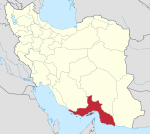Laft
Laft
Persian: لافت | |
|---|---|
City | |
 Laft harbor | |
| Coordinates: 26°53′50″N 55°45′40″E / 26.89722°N 55.76111°E[1] | |
| Country | |
| Province | Hormozgan |
| County | Qeshm |
| District | Central |
| Population (2016)[2] | |
| • Total | 4,668 |
| Time zone | UTC+3:30 (IRST) |
Laft (Persian: لافت, also Romanized as Lāft; also known as Bandar-e Lāft, Lāft-e Now, Luft and Yāft)[3] is a city in the Central District of Qeshm County, Hormozgan province, Iran. Laft is more than 2,000 years old. It is on Qeshm Island in the Straits of Hormuz, to the southwest of Bandar Abbas.
At the 2006 census, its population was 3,899 in 765 households, when it was a village in Howmeh Rural District.[4] The following census in 2011 counted 4,105 people in 952 households.[5] The latest census in 2016 showed a population of 4,668 people in 1,216 households.[2]
After the census, the village of Laft was elevated to the status of a city.[6]
Description[edit]
Laft is surrounded by Hara forests (mangroves). The most obvious architectural features of the houses is their variously-sized windbreaks (windtowers). The people of Laft constructed them for making the inner space of the building cool in summer. The buildings of Laft are constructed close to each other, with winding and narrow alleys.

Historical monuments in Laft include Naderi Castle, a square-shaped castle with four towers; two rounded dome-like reservoirs; a burial ground in which some of the inscriptions are dated to 1000 years ago; and the shrines of Seyed Hassan Mansor, Sheikh Tousi, and Sheikh AndarAbi. Behind the castle, in a crater, 366 Tala (Golden) wells were dug for gathering the rainwater, one for each day of the leap year in Iran. Some historians believe that these wells date from the time of the Achaemenian and Sassanian dynasties.[citation needed]
At Laft harbor, there is a dock which is related to Median, Achaemenian, and Sassanian dynasties.[citation needed] This dock is about 130 m long and the main seabed thick of about 7 m. The walls at the dock are about 3 m that are made up bevelled stones.
Near Laft a 220 kV-powerline crosses Ghesm strait.


Sheikh AndarAbi Island[edit]
Across from Laft and Khamir harbors, there is a very small island which is named Sheikh AndarAbi. Some parts of this small island are covered with water at high tide. The distance between Laft harbor and Sheikh AndarAbi Island can be covered by a speedboat in less than 5 minutes. At the north margin of Sheikh AndarAbi Island, the surface of the land is lower than other parts of the island and there are many Hara trees. At the southeast margin of the island there is a famous dome which is popular as the Shrine of Sheikh AndarAbi or Qadamgah-e Sheikh (footprint of the Sheikh). At high tide seawater covers the majority of the Island. Nowadays, nobody lives there, and fishermen and sailors are still respecting this island.
References[edit]
- ^ OpenStreetMap contributors (11 September 2023). "Laft, Qeshm County" (Map). OpenStreetMap. Retrieved 11 September 2023.
- ^ a b "Census of the Islamic Republic of Iran, 1395 (2016)". AMAR (in Persian). The Statistical Center of Iran. p. 22. Archived from the original (Excel) on 5 May 2022. Retrieved 19 December 2022.
- ^ Laft can be found at GEOnet Names Server, at this link, by opening the Advanced Search box, entering "-3072726" in the "Unique Feature Id" form, and clicking on "Search Database".
- ^ "Census of the Islamic Republic of Iran, 1385 (2006)". AMAR (in Persian). The Statistical Center of Iran. p. 22. Archived from the original (Excel) on 20 September 2011. Retrieved 25 September 2022.
- ^ "Census of the Islamic Republic of Iran, 1390 (2011)". Syracuse University (in Persian). The Statistical Center of Iran. p. 22. Archived from the original (Excel) on 17 January 2023. Retrieved 19 December 2022.
- ^ "Four villages in Hormozgan were upgraded to cities". Mehr News (in Persian). Ministry of Interior. 1 August 2021. Archived from the original on 9 September 2023. Retrieved 9 September 2023.
Further reading[edit]
- الكوخردى ، محمد ، بن يوسف، (كُوخِرد حَاضِرَة اِسلامِيةَ عَلي ضِفافِ نَهر مِهران) الطبعة الثالثة ،دبى: سنة 199۷ للميلاد Mohammed Kookherdi (1997) Kookherd, an Islamic civil at Mehran river, third edition: Dubai
- کامله،القاسمی، بنت شیخ عبدالله، (تاریخ لنجة) مکتبة دبي للتوزیع، الامارات: الطبعة الثانية عام ۱۹۹۳ للمیلاد
- الوحیدی الخنجی، حسین بن علی بن احمد، «تاریخ لنجه» ، الطبعة الثانية دبی: دار الأمة للنشر والتوزیع، ۱۹۸۸ للمیلاد
- اطلس گیتاشناسی استانهای ایران [Atlas Gitashenasi Ostanhai Iran] (Gitashenasi Province Atlas of Iran)


